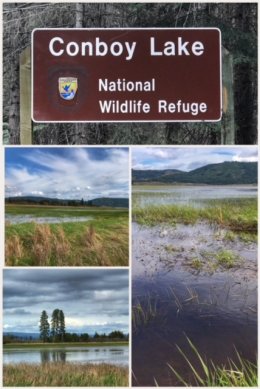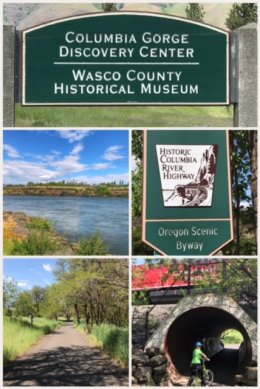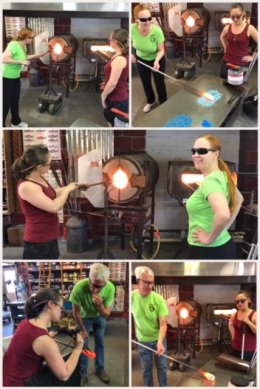 We hit the Columbia River Gorge at the perfect time. The weather was wonderful, the trees and plants all green, and wildflowers blooming everywhere you looked! Just wow. (Side note: It is also very windy in the Gorge!)
We hit the Columbia River Gorge at the perfect time. The weather was wonderful, the trees and plants all green, and wildflowers blooming everywhere you looked! Just wow. (Side note: It is also very windy in the Gorge!)
We saw arrowleaf balsamroots, lupines, lilacs, bachelor buttons, larkspur, camas, penstemons, wooly vetch, and California poppies.
We used White Salmon as our home base for exploring all around the Gorge — our first foray into Washington — visiting another wildlife refuge, hiking to a waterfall near Mt. Hood, riding our bikes along a river trail, attempting glass-blowing for the first time, driving to Maryhill to see a duplicate of Stonehenge, and partaking in a river cruise along the Columbia River.
Fun facts about the Columbia River: At 1,243 miles long, it is the 4th largest in the U.S., and the largest in the Pacific Northwest — and the biggest hydroelectric power producer in all of North America, producing more than 24 Gigawatts of electricity. It was known as the Wimahi by the Chinook Indians before being claimed and named the Columbia by Captain Robert Gray in 1792.
 We started our adventure with a short drive north to the Conboy Lake National Wildlife Refuge. In terms of wildlife refuges, this one was certainly pretty — and important — but not “the jewel” some tourism sites described it to be. In fact, we were kind of disappointed with this refuge. We found no interpretative signs and no information on trails we could take. That said, it was a fun drive through the countryside and we took it upon ourselves to hike out to the lake and see a few waterfowl!
We started our adventure with a short drive north to the Conboy Lake National Wildlife Refuge. In terms of wildlife refuges, this one was certainly pretty — and important — but not “the jewel” some tourism sites described it to be. In fact, we were kind of disappointed with this refuge. We found no interpretative signs and no information on trails we could take. That said, it was a fun drive through the countryside and we took it upon ourselves to hike out to the lake and see a few waterfowl!
Later that day, we also hiked to parts of the Catherine Creek area of the Columbia River Gorge National Scenic Area, located along Old Highway 8. The south side offers a paved path with many interpretative signs, including how the area had once been known as “Sunflower Hill” because of all the balsamroots — until cattle grazing wiped them out. (It is now under restoration and quite beautiful to behold.) The north side offers two different trails, and we took the one that hiked up into the hills so that we could get some amazing views of the Columbia Gorge.
 Next up was a trip back to Oregon’s Mt Hood, driving along the Mount Hood Scenic Byway — and ending with a 4-mile (round trip) hike to Tamanawas Falls.
Next up was a trip back to Oregon’s Mt Hood, driving along the Mount Hood Scenic Byway — and ending with a 4-mile (round trip) hike to Tamanawas Falls.
This trail head is found on the east slope of Mount Hood and follows the Cold Spring Creek — and is shaded by large Douglas fir, cedar and a variety of trees and shrubs. At the end of 2 miles, you come to the falls — which are approximately 100 feet high and 40 feet wide, falling off a lava cliff. The hike is well worth an afternoon of quiet, beauty, and phytoncides!
 The following day, we grabbed our bikes and hit the Riverfront Trail of the Dalles, on the Oregon side of the Columbia — starting at the Columbia Gorge Discovery Center in The Dalles.
The following day, we grabbed our bikes and hit the Riverfront Trail of the Dalles, on the Oregon side of the Columbia — starting at the Columbia Gorge Discovery Center in The Dalles.
The trail is a mix of beauty and industry, traveling along some very scenic areas as well as through some industrial areas — including a massive Google data complex. We saw many wildflowers along our bike ride — and even a train as we were passing under a special tunnel they dug out under the tracks just for the trail. (We love trains, so that made it all the more exciting!)
 The next day started with a trip back to The Dalles for an adventure in glass-blowing, something we had been intrigued with since we had visited the Oregon coast and had been told there were glass studios that gave lessons and allowed you to blow your own glass object (such as an ornament, a float, a heart, a mug).
The next day started with a trip back to The Dalles for an adventure in glass-blowing, something we had been intrigued with since we had visited the Oregon coast and had been told there were glass studios that gave lessons and allowed you to blow your own glass object (such as an ornament, a float, a heart, a mug).
We finally got our chance at Nichols Art Glass — with the help of Rachel, who was an excellent instructor. We both decided to blow ornaments — which we plan to hang in the RV near our dining area windows. Jenny designed a sky-themed ornament (with blues and white), while Ran designed a forest/wildflower-themed ornament (with green and yellow).
 After leaving our ornaments to cool, we headed east and north across the river to Maryhill, Washington, home of a failed Quaker utopian community attempted by road-paving pioneer and industrialist Sam Hill– which now includes the Stonehenge memorial, an art museum, and a winery.
After leaving our ornaments to cool, we headed east and north across the river to Maryhill, Washington, home of a failed Quaker utopian community attempted by road-paving pioneer and industrialist Sam Hill– which now includes the Stonehenge memorial, an art museum, and a winery.
The Stonehenge replica was built by Hill as a memorial to the human sacrifice of war, making this is the earliest World War I war memorial in North America. It sits up on a ledge, and is most certainly worthy of a stop. It also offers amazing views of the Columbia.
We were too late for a stop at the museum — housed in Hill’s elaborate mansion — and which curates various collections of art.
Happily, we were not too late for a tasting at Maryhill Winery, a family-owned winery founded in 1999, and now one of Washington’s largest and most visited wineries — and which includes a 4,000-seat outdoor amphitheater used for summer concerts. We met some fellow travelers — Evan and Beth — while tasting, which made for a fun time. We didn’t love all their wines, but did leave with a few bottles, which is our custom.
We ended the day with a short hike to Horsethief Butte in Columbia Hills Historic State Park, a 1.5-mile round trip hike near sunset, which again offered more amazing views of the Columbia River during that Golden Hour light.
 We ended this stop in the Gorge with another to-do on our list — a river sightseeing cruise. We traveled back to Oregon, to Cascade Locks, to board the Columbia Gorge Sternwheeler for a 2-hour river adventure. The Sternwheeler is designed to be reminiscent of the ships that traveled the Gorge in the 1800s — and includes a triple-deck paddle wheeler in the back. We cruised both east and west, under the Bridge of the Gods — and, sadly, got another first-hand look at the fire damage from last year’s Eagle Creek Fire. We also got to see Indian fishing platforms all along the river. The narration could have been more detailed — and simply just more — but the fresh air and scenic beauty definitely made it worth the price.
We ended this stop in the Gorge with another to-do on our list — a river sightseeing cruise. We traveled back to Oregon, to Cascade Locks, to board the Columbia Gorge Sternwheeler for a 2-hour river adventure. The Sternwheeler is designed to be reminiscent of the ships that traveled the Gorge in the 1800s — and includes a triple-deck paddle wheeler in the back. We cruised both east and west, under the Bridge of the Gods — and, sadly, got another first-hand look at the fire damage from last year’s Eagle Creek Fire. We also got to see Indian fishing platforms all along the river. The narration could have been more detailed — and simply just more — but the fresh air and scenic beauty definitely made it worth the price.
Next up? Volcanic mountain adventures at Mt. Rainier and Mt. St. Helens.
